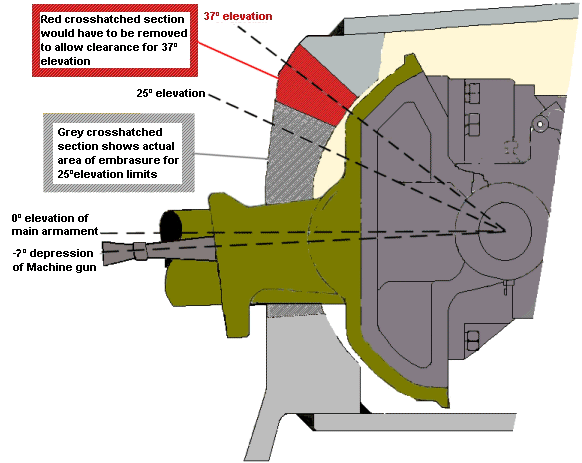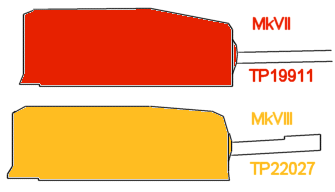95mm Howitzer armed Churchills.
by S. Osfield
The story of the 95mm Howitzer illustrates the lack of control and direction of the British Ordnance during World War 2. It started life as one of those “let’s design what the enemy has” projects, to emulate the STUG III and to better the 7.5cm KWK 37 support weapon fitted to the early variants of the Panzer IV. The plan was put to the Tank Board in December 1941 for an SPG based on the Valentine tank and a tank mounted weapon to replace the existing much criticized 3inch Howitzer. Eventually the SPG emerged on the Harry Hopkins light tank chassis, limited production starting in late 1944. The Harry Hopkins 95mm SPG as it was known, mounted a different mark of 95mm- the Mk3, with a separate brass cartridge and three bag charges, giving incremental muzzle velocities of 523fps, 839fps and 1,111fps. The A22 and A27 close support tanks used the Mk1 with a fixed round with none adjustable charge firing a shell at 1075fps. At first glance this may seem a minor difference but this bazaar situation required two sets of ammunition, range tables and a different training regime for the gun crews, the Harry Hopkins SPG was in effect to be manned by Royal Artillery trained personnel. The use of the Mk3 weapon in Harry Hopkins SPG was due to components of the erstwhile Mk2 infantry gun being used to alleviate a shortage of the Mk1 weapon in mid 1944, although the Mk3 could not of course be used in MkV or MkVIII Churchills, as it would have caused a logistical and training nightmare.
The design weight limit of the new generation of tank turrets precluded fitting an existing weapon such as the 25pdr (barrel weight 1000lb) although it would be interesting to know if anyone really bothered to see if it could be done! As originally mooted the 95mm gun was to be built to the weight of the 6pdr gun, however due to the howitzers short barrel length of 21cal it became necessary to balance the mounting with a 150lb counter weight taking its total weight to 867lb. Again this does not seem to have been thought out, an increase in barrel length of about 5cal could have balanced the gun and probably given improved accuracy, one of the original designs was for a shorter, lighter barrel of 15cal. with total barrel weight of 517lb, so it could not be argued that 21cal was the only viable length.
The design seemed the ideal solution using a plethora of existing components, thus when first officially announced at the DTD on 12th December 1941 it was confidently (naively) predicted that the weapon would fit any contemporary tank capable of mounting the 6pdr tank gun. However nothing is that simple and on 29th May 1942 the DAFV announced that the weapon would require a special mounting if not a completely redesigned turret for the Churchill and by the time it could be reasonably expected production only the A27 and possibly the Churchill would still be in production. In reply to further enquiries by DAFV the armament specialists concluded that if the DAFV would accept a reduced range of 2400yards, then the project could continue without a redesign of the turrets of the later tanks, the DAFV pointedly would not accept this as the specified range was to be 5500 to 6000 yards and after time for further reflection another proposal on the 25th June 1942 postulated if the mounting and turrets were slightly modified then the project could go ahead.
The main problem was
elevation, there is to this day a belief that the 95mm Close support weapon
in Churchills and A27s was capable of a 37º elevation, this is wrong.
If any 95mm weapon was capable of an elevation of 37º it was on the
proof mountings on test ranges. Had the 95mm Howitzer been capable of
elevating to 37º it would have required a much larger embrasure than
that existed on any of A22 and A27 tank turrets. In the case of the Churchill
VIII, the easiest to see the scale of such an aperture, it would have
extended to the lip of upper face of the turret, see sketch of MkVIII
forward turret section.

Alternatives would have required a sloping front turret requiring the trunnions to be placed further back, this might have worked in a Cromwell with its larger turret ring but in a Churchill it would have led to interference with the turret ring especially at higher elevation with fixed tank ammunition. Attempts to fit the weapon in the turret of the Churchill Mk3 and Mk4 revealed that the elevation was limited by the obscuration of the sights by the triangular segment in the left upper portion of the mantlet embrasure thus restricting the direct fire range. As the production of armour plate for the Mk3 turrets was already well in hand further effort was directed to utilise the cast Mk4 turret and after removing the offending segment and further modification of the mantlet it was found that the gun was capable of sufficient elevation of 25º and depression of 10º but only in broadside position. The original 6pdr depression limiter was retained to avoid the weapon firing into the track covers. Additionally, the barrel removal plate in the turret bustle was enlarged. This was the modification that was accepted for service after the meeting of the DTD on 25th June 1942. Work continued with the design but problems continued, the ammunition originally was that of the 3.7inch mountain howitzer which remained in service particularly in the Far East, this proved unsuitable, so the weapon was further delayed by the need to design ammunition and to re-write range tables. Again although much effort was reputed to have been expended on the new shells the end results were somewhat under whelming being not that dissimilar to the 3.7inch, the HE-AT shell in particular was a peculiar ball type shaped charge.
It would be April 1943 before user trials could be carried out and the MkV Churchill replaced remaining MkIs in home service in the run up to D.Day whether these crews actually got any firing time with the new weapon is another matter. From some user reports the weapon was a dead loss being only effective as a smoke weapon having a dispersion of 100yards at more than 2000yards, hence its value to deliver either HE or HEAT rounds was negligible. Although one report stated that the HEAT shell could penetrate a 102mm plate at 2400yards a truly remarkable feat considering at this range the strike could be anywhere in a 40feet by 40feet impact area. Obviously something was wrong, there were demands for its replacement with standard 75mm gun tanks and by late 1944 the DTD was requesting development of a new weapon based on the calibre and performance criteria of the US 105mm howitzer M4.
When the new A42 Churchill was approved a 95mm armed variant was demanded even though there was no longer a realistic requirement for the type. Because of muddled thinking and overt political interference the number of MkV turrets already exceeded the weapons available and this led to a number of tanks being armed with 6pdr and 75mm guns in the MKV style turret casting, which by default meant that the primary weapon systems were now interchangeable, this happy circumstance would promptly be lost with the design of the new MkVIII turret.
Production of the new MKVIII started slowly possibly due to a shortfall in the 95mm weapons production, no MkVIIIs were expected until October 1944 and on one occasion it was threatened with termination in favour of MkVIIs. It would seem that no MkVIIIs reached active service units. As a design the MkVIII turret is notable, some references state that it was larger than the MkVII turret, the reality was more complex, the turret bustle was about 4 inches longer than the MkVII turret, a compensatory reduction in weight was made by reducing the height of the rear section of the turret by 1.75 inches giving a less pronounced slope to the front roof. The turret front was actually slightly higher than the MkVII with a very slight slope of the front plate above the trunnion axis. The reduction of height of the roof and the slight slope of the front plate precluded its use in MkVII production, as the 75mm gun would have had a restricted depression. This reconfiguration may be evidence that the a MkVII turret if fitted with a 95mm weapon would be unbalanced making turret traverse a problem and that the A22F series turrets were overloading the hull, this could have had implications for the programme to rebuild of Churchills to MkIX to XI (heavy turret) standard.

A number of MkVIIIs were fitted with the additional (tropical) ventilator on the turret rear, this was also problematic, overloading the battery and electrical system, the necessary remedial action thus delaying further the service acceptance of the tank, although how much remedial work is required to fit larger capacity batteries, or remove a fuse or tape over the switch or even cut the cable to the fan?
The mounting was redesigned allowing the main armament and the co-axial Besa each to have a different elevation. The Besa was misaligned by minus 7º when the main armament was level. This novel arrangement had some merit, the 95mm howitzer did not need to have a depression of more than –3º, as the nature of the howitzer was such that at a deeper angle the shell would have such a short flight time that the centrifugal bolt might fail to operate, thus preventing the activation of the fuse. This had the incidental benefit that the depression limiter could be eliminated. With regard to the Besa, targets were more likely to be engaged within the normal elevation limits of the 75mm gun tank and the sights (range tables) reflected this, for obvious reasons engaging the enemy with a rifle calibre weapon in near vicinity of the tank is more relevant than trying to hit a very small target at a theoretical extreme range, although long range indirect fire using 7.92mm Besa was used on a few occasions.
Although the 95mm
Howitzer remained in service into the 1950s, it could not be regarded
as a successful design, it was as least as inaccurate as the weapon it
was to replace and was designed to a weight limit it promptly exceeded.
Note; With regard to standard references the following should be noted,
- HMSO Churchill Tank Vehicle and Specification: The sectional drawing of the Mk8 turret lacks the depression aspect of the mantlet embrasure. The breach ring is completely missing from the drawing.
- Mr Churchill's
Tank page 95: The photo of the turret basket is actually from a Cromwell
or Centaur.
© Steve Osfield 2002
Acknowledgement:
Special thanks to Chris Shillito for additional information regarding
the configuration of the MkVIII turret and general information regarding
dates of DTD meetings.